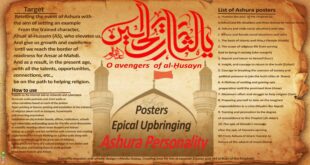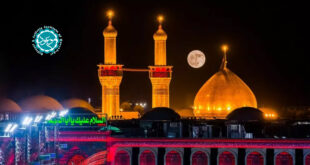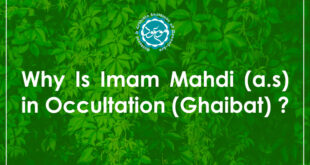The Public Call
As the number of committed Muslims began to grow, Almighty Allah commanded His Prophet to publicly announce the call to Islam. Some of the notable converts at this stage included Muhammad’s [s] kinsmen such as Ja’far bin Abi Talib, Ubaidah bin Hareth bin Abdul Muttalib and etc…
The growing presence of such a strong Muslim community in their midst naturally annoyed the obstinate polytheists, who felt increasing danger to their hegemony. The infidels, who had no logic to defend their worship of manmade objects and stop the awakened masses from flocking toward the light of Islam, resorted to torture and other methods of oppression against the fledgling Muslim society. Bilal the Abyssinian, Suhaib the Roman, Khabab bin Art, and others underwent the most rigorous forms of torture at the hands of arrogant Jahiliyah.
The Mission Continues
Despite the hardships, the infant community of Islam stood steadfast in its beliefs. The Prophet’s wife Khadija bint Khwailid who was blessed with a large fortune, put all her wealth and property at her husband’s disposal, to help the spread of Islam. The personality of Abu Talib, Muhammad’s [s] uncle, who was respected and admired by the Quraish, was instrumental in keeping the polytheist Arabs at a distance, and they were afraid of doing any bodily harm to the Prophet. The Prophet continued to teach the young Muslim community, the divine revelations and the basic tenets of Islam. His most enthusiastic disciple and student was none other than his young cousin, Ali, who was the closest personality to Muhammad [s].
A point to note is that while all the early Muslims were mature people and had experienced the fruits and bitterness of growing up among the idols of Arabia, it was only Ali, who entrusted to his cousin’s guardianship years before the call of Islam, was like Muhammad [s] – of a pristine pure personality and far removed from contemporary corruption. Perhaps it was divine providence that Ali should be groomed personally by the last and greatest Messenger to mankind. Hence, the young Ali imbibed all the knowledge directly from the Prophet himself.
Consequently the Da’wah (Islamic Call) of the Prophet falls into two clearly discernible periods as follows:
1. The period in Makkah, beginning with the age of 40 till his emigration to Madina 13 years later.
2. The period at Madina, beginning with the Prophet’s historical arrival till his sad demise 10 years later at the age of 63.
The Makkah Period
If the Prophet’s emigration to Madina opened new vistas for the message of Islam and its eventual expansion over the Arabian peninsula, nonetheless the Makkah period despite the persecution and hardships, was instrumental in laying the firm foundations of Monotheism, which were to flower in Madina later on.
Briefly speaking, the major landmarks of the Islamic call in this period are explained underneath for our readers:
1. The First Revelation
The coming of the Archangel Gabriel with the tidings of Prophethood and the first revelation, as we have already explained.
2. Da’wat Dhul-Ashira
The invitation to his kinsmen the Bani Hashim to accept Islam. The event known as Da’wat Dhul-Ashira was a formal announcement of Muhammad’s [s] mission and a turning point in the history of the divine message and its spread. Undeterred it set the tone for the making of the first group of dedicated Muslims, who despite severe persecution and hardships gathered around the Prophet to assimilate the teachings and principles of Islam.
3. Isra
The night journey Isra as described by the glorious verses of the Holy Qur’an.
“Glory be to Him Who made His servant to go on a night from the Sacred Mosque to the Remote Mosque of which We have blessed the precinct…”
Holy Qur’an (17:1)
What is meant by Isra is the bodily ascension of Prophet Muhammad [s] from the Sacred Mosque (Ka’aba) to the Remote Mosque in Jerusalem[9] and thence to the heavens to the very presence of Almighty Allah, and back to earth in a very short span of the same night. It is related that Gabriel descended one night with the heavenly mount Buraq whose speed as the name suggests is far greater than the speed of light, and took the Prophet to the highest and furthest point of the heavens where no creature has ever set foot, and thence the wonder-struck Muhammad [s] proceeded alone to the very presence of the ‘Magnificent Light’, that only a curtain divided him from the Omnipotent Almighty. Then Allah spoke with his servant and showed him the signs of His Majesty. The event also known as Me’raj confirms that no creature ever, not even the past prophets or any heavenly being either, like the Archangel Gabriel, had been so near to the Almighty’s proximity, as the Habibullah (beloved of Allah) was summoned by Allah that night.
4. The First Martyrs
The idolaters maddened at Bani Hashim and other Makkans for accepting Islam, singled out some Muslims like Bilal the Abyssinian, Ichabab bin Art and Yasir, his wife Sumaiyya and their son Ammar for severe torture. Despite the barbarities inflicted, the new Muslims refused to forego their faith in monotheism and eventually Yasir and his wife Sumaiyya were savagely martyred at the hands of the infidels.
5. The Emigration to Abyssinia
When the Messenger of Allah felt the growing danger threatening the very lives of the infant Muslim community and its helplessness against the infidels, he instructed some of them to migrate to Abyssinia. The immigrants were led by the Prophet’s cousin Ja’far bin Abu Talib, and upon arrival there, were allowed to settle and practice their faith by the Abyssinian ruler Negus.
6. Siege and Social Boycott
Alarmed at the growing number of Muslims and fearing to do bodily harm to the Prophet, because of Abu Talib’s towering personality, the Makkan Jahiliyah devised a plan of social boycott of the whole Bani Hashim clan.
Hence a total boycott was imposed on the Bani Hashim and the new Muslims to such an extent that all links or contacts whether commercial or social, including buying or selling of goods and even matrimonial alliances were severed. But the faithful Abu Talib was determined to protect his nephew the Prophet, and together with all his clan members as well as the other Muslims retired to the valley known as Shi’b Abi Talib on the outskirts of Makkah, where together, they could easily override the difficulties and also protect themselves from any incursions. Steadfastly, the Muslims bore the consequences of the siege, enduring pain, hunger and other difficulties for three long years, and ultimately frustrated the infidel’s efforts, which forced the Makkan Jahiliyah to lift up the social boycott.
7. The Year of Great Grief
Shortly after the Bani Hashim and other Muslims emerged from Shi’b Abi Talib, a double calamity struck the Prophet. Umm al-Mu’mineen (mother of believers) Khadija al-Kubra who had given her husband unflinching support, sacrificing her great wealth and property for the cause of Islam, finally succumbed to the hardships and breathed her last. It was a great blow to the Prophet to lose his faithful beloved companion and the mother of his illustrious progeny. But another calamity was in store for Muhammad [s], and three days later that another great benefactor and sincere guardian, his uncle Abu Talib passed away from this mortal world.
These sad events occurred in the holy month of fasting, Ramadhan, three years before the Prophet’s historic migration to Madina. Accordingly the year is known in the annals of Islamic History as the ‘Year of Grief’.
8. The Retirement to Ta’if
Aggrieved by the double loss of his loving wife and doting uncle, and faced with the prospect of renewed hostility from the Makkan idolaters, who were emboldened by Abu Talib’s death, the Prophet set out for the oasis town of Ta’if. But in Ta’if the call to Islam fell on deaf ears. No one believed in Muhammad’s [s] invitation except an old Christian farmer called ‘Adhasu’ who embraced Islam. The Arabs of Ta’if ridiculed the Prophet, encouraging simpletons and ignorant children to pelt him with stones and obstruct his path, wherever he moved. The Messenger convinced that his divine mission would not make much progress with the stonehearted people of Ta’if, returned back to his birthplace Makkah.
9. Meeting with a Yathrib Delegation
Even though the arrogantly ignorant Quraishites and other tribes of Makkah and Ta’if had scoffed at the message, divine providence was already at work facilitating help and the spread of Islam from hitherto unknown quarters. In the eleventh year of the Prophetic mission, Muhammad [s] started contacts with delegations. He came across a group of people from Yathrib led by As’ad bin Zurara of the Khazraj tribe and invited them to Islam. His words received an attentive response, and the group believing in the truthfulness of this great monotheistic call became very happy. The leader asked the Prophet to send a Muslim with him to Yathrib to preach Islam, and hoped that the divine call would unite his tribe with the rival tribe of Aws, knitting them into a single Muslim people.
 Mouood Mouood English Edition
Mouood Mouood English Edition




